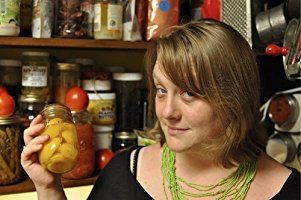It all happens in Marisa McClellan’s tiny kitchen
By Sabrina Emms
She may can in her grandmother’s kitchen but she isn’t making her grandmother’s jam. Armed with a potato masher and a worn wooden spoon, Marisa McClellan is a kitchen revolutionary.
McClellan wants to lead city folk back to their tiny kitchens, and, on those modern hearths, breathe life back into the art of canning.
Like other DIY pursuits, canning may be making a comeback. McClellan, through her blog and then her books, has had quite a bit of influence on the Philadelphia canning scene. She is using this influence to encourage adventurous, brave canning, for everyone from beginners to experts like herself.

—- Marisa McClellan
In her Amazon author’s profile McClellan looks more scrap booker than rabble-rouser, in her late 30s, with shoulder-length blond hair, and a large, bright, necklace. She looks far too young for old school canning’s target demographic. On the surface, her books promise to teach people to make their own delicious seasonal jams. Her deeper mission is to demystify the production of canned goods, encouraging people to forgo store bought and make their own. She doesn’t sell her jams, jellies, preserves or chutneys,
“Urban canning”, is what McClellan calls it in her books and on her popular blog, Food in Jars. “Up until recently all canning recipes were written for people who were canning in order to have enough food to make it through the winter.” McClellan explained to Mother Nature Network an online new source. Her passion — small batch urban canning — liberates canning from its previous function. Preservation brought McClellan back to canning but her blog has taken spectacular leaps from there. Already a food writer when she started Food in Jars in 2009, McClellan paired innovative, often beautifully colored combinations, with easy instructions and charming anecdotal writing. Soon, gleaming jewel-tone jars filled her shelves and food writing flowed with the ease of a natural talent. “Writing about food felt the most natural, an abundant and juicy area,” she explained.
McClellan isn’t just about unique or intriguing flavors, she also wants to share the joy and satisfaction of canning, and to extinguish some of the fears. “Hear me now. If you stick to the high-acid foods—most jams, fruit butters, and pickles—you are not going to kill anyone,” she writes in her third book, “Naturally Sweetened Food in Jars”. McClellan tells new canners that while there are real dangers in canning, like botulism, the acidity in jams blocks the growth of the botulinum bacteria. Continue reading
